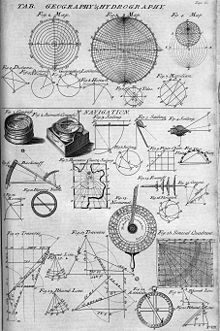
Navigation is a field of study that focuses on the process of monitoring and controlling the movement of a craft or vehicle from one place to another.
It is also the term of art used for the specialized knowledge used by navigators to perform navigation tasks. All navigational techniques involve locating the navigator's position compared to known locations or patterns.
Navigation, in a broader sense, can refer to any skill or study that involves the determination of position and direction. For information about different navigation strategies that people use, visit human navigation.
In the European medieval period, navigation was considered part of the set of seven mechanical arts, none of which were used for long voyages across open ocean. Polynesian navigation is probably the earliest form of open ocean navigation, it was based on memory and observation recorded on scientific instruments like the Marshall Islands Stick Charts of Ocean Swells. Early Pacific Polynesians used the motion of stars, weather, the position of certain wildlife species, or the size of waves to find the path from one island to another.